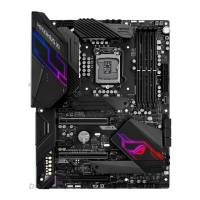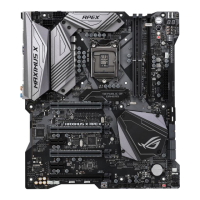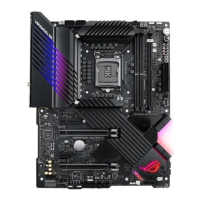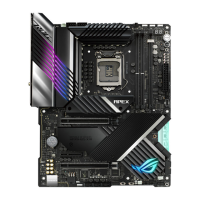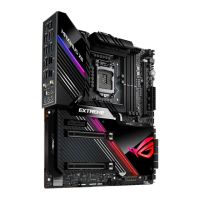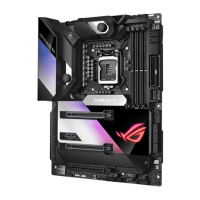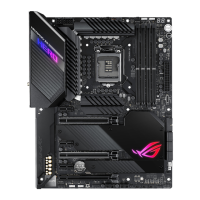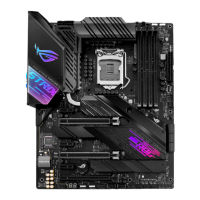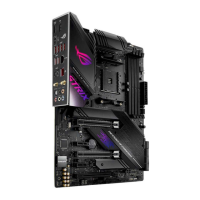Do you have a question about the Asus ROG Maximus XI Gene and is the answer not in the manual?
Guidelines to prevent electrical shock hazards when working with the system and components.
Instructions for safe handling, installation, and operation of the motherboard and system.
Outlines the structure of the manual, covering product intro, installation, BIOS, and RAID.
Provides resources for additional information and product/software updates from ASUS.
Explains warning symbols (DANGER, CAUTION, IMPORTANT, NOTE) used throughout the manual.
Defines text formatting like bold, italics, and key notation for user instructions.
Details CPU socket, chipset, and memory specifications including DDR4 speeds.
Covers PCIe slots, integrated graphics support, and storage interfaces like M.2 and SATA.
Details LAN, Wi-Fi, Bluetooth, audio codec, and various USB port specifications.
Highlights ROG exclusive features, Dual Intelligent Processors, and EZ DIY options.
Lists all rear panel connectors and details internal headers for various system components.
Outlines BIOS ROM size, manageability, bundled software, OS support, and physical dimensions.
Lists the main motherboard unit and essential cables included in the package.
Details included accessories, support DVD, and the user guide.
Illustrates components like PC chassis, PSU, CPU fan, CPU, DIMM, and drives.
Shows tools like screwdrivers and optional parts like graphics cards and M.2 modules.
Introduces the motherboard and its general layout and features.
Provides crucial safety precautions before handling motherboard components.
Visual representation of the motherboard with numbered components and connectors.
Lists and describes various connectors, jumpers, buttons, and slots on the motherboard.
Details CPU socket type (LGA1151) and processor compatibility.
Emphasizes safe handling, PnP cap, and warranty considerations for CPU installation.
Explains the presence and type of DIMM slots (DDR4).
Warns against installing incompatible DDR memory modules in DDR4 slots.
Explains how memory sizes are mapped for dual-channel configuration and single-channel operation.
Provides tips on installing DIMMs for stability, compatibility, and overclocking.
Identifies and describes the PCIe slots (x4 and x16/x8) on the motherboard.
Explains the function of the onboard Power-on and Reset buttons.
Details the MemOK! II switch for memory re-training and troubleshooting boot failures.
Explains the Safe Boot and ReTry buttons for BIOS safe mode and retry POST.
Describes the Slow Mode and Pause switches for extreme overclocking scenarios.
Explains the LN2 Mode jumper for cold-boot bug remedy and 80 light jumper for Q-CODE LED.
Details the jumper for enabling/disabling the motherboard back light.
Explains the Q LED system for checking boot components and diagnosing errors.
Describes LEDs that indicate water condensation on critical components.
Explains the HD_LED for indicating hard disk activity.
Explains the Mem_LED for indicating MemOK! II function status.
Details the 2-digit Q-Code LED for displaying system status and error codes.
Explains the SATA connectors for hard drives and RAID configuration.
Describes the connector for the chassis-mounted front panel audio module.
Details the connector for attaching thermistor cables to monitor temperatures.
Explains the connector for additional USB 3.1 Gen 2 front panel ports.
Details the connector for additional USB 3.1 Gen 1 front or rear panel ports.
Describes the connectors for USB 2.0 ports and the warning about 1394 cables.
Explains the LED connector for attaching LED strips to the back I/O cover.
Details the 4-pin RGB headers that support multi-color LED strips.
Explains various fan and pump connectors (CPU, AIO, Water Pump) and their pin configurations.
Details connectors for monitoring liquid cooling system temperature and flow rate.
Explains the NODE connector for compatible PSU or fan extension card control.
Details the M.2 sockets for installing M.2 SSD modules and their specifications.
Describes the ATX power connectors and PSU requirements for system stability.
Details connectors for system power LED, HDD LED, power button, and reset button.
Explains the DIMM.2 slot for connecting M.2 SSD modules and its specifications.
Details the ROG ProbeIt feature for detecting system voltage and OC settings.
Introduces the PC system building process and notes that diagrams are for reference.
Provides step-by-step instructions and precautions for installing the CPU.
Emphasizes ensuring the CPU is firmly clicked into place and covers warranty exclusions.
Instructs on applying Thermal Interface Material to the CPU and cooler.
Details the steps for installing the CPU heatsink and fan assembly.
Describes aligning I/O ports and securing the motherboard with screws.
Provides step-by-step instructions for installing RAM modules into DIMM slots.
Details the procedure for safely removing RAM modules from DIMM slots.
Explains how to connect the 24-pin ATX and 8-pin power connectors.
Illustrates how to connect SATA power and data cables to storage devices.
Guides on connecting Q-Connector, USB (Gen 1, Gen 2, 2.0), and front panel audio.
Details the procedure for installing expansion cards into PCIe x16 slots.
Provides step-by-step instructions for installing M.2 SSD modules.
Guides on installing M.2 SSDs using the DIMM.2 module.
Covers safety, orientation, M.2 type support, IRST, and slot interaction.
Explains how to connect the ASUS 2x2 dual band Wi-Fi antenna to the chassis ports.
Details how to update BIOS using USB BIOS Flashback without entering BIOS.
Identifies all rear panel connectors like USB, LAN, HDMI, and audio ports.
Explains LAN port LEDs and audio port definitions for various channel configurations.
Illustrates connecting headphones and microphones to the audio jacks.
Guides on connecting stereo and 2-channel speaker systems to the audio ports.
Illustrates connecting surround sound speaker systems to the audio ports.
Outlines the steps for starting the system for the first time after installation.
Provides a table of BIOS beep codes and their corresponding error descriptions.
Introduces the ASUS UEFI BIOS interface and its features.
Explains circumstances requiring BIOS setup or updates and related warnings.
Details methods to enter BIOS Setup during startup or after POST.
Provides tips on mouse usage, default settings, CMOS clearing, and unsupported devices.
Explains the Advanced Mode for experienced users to configure BIOS settings.
Explains EZ Mode for basic system info, language, performance, and boot priority.
Lists and describes main menu items like My Favorites, Main, Extreme Tweaker, etc.
Explains Language selection, My Favorites, Q-Fan Control, and AI OC Guide features.
Details Search function, AURA RGB control, and accessing BIOS FAQ via QR code.
Explains scroll bars, general help, configuration fields, and hot keys for navigation.
Introduces EZ Tuning Wizard for easy RAID configuration.
Explains the button to view recently modified and saved BIOS items.
Details how to set fan profiles (Standard, Silent, Turbo, Full Speed, Manual) for CPU/Chassis fans.
Guides on manually adjusting fan speed points by dragging on the curve.
Explains how to enable and use the AI Overclocking feature for automatic overclocking.
Guides on using EZ Tuning Wizard to easily set up RAID configurations.
Details options like Easy Backup (RAID 1/10) and Super Speed (RAID 0/5).
Explains how to save and access frequently used BIOS items in My Favorites.
Guides on adding BIOS items, managing favorites, and limitations.
Describes the Main menu for system info, date, time, language, and security.
Details the Extreme Tweaker menu for configuring overclocking-related settings.
Explains Ai Overclock Tuner (Auto, Manual, XMP) and BCLK Frequency settings.
Covers MultiCore Enhancement, CPU Core Ratio, DRAM Frequency, and CPU Power Management.
Introduces the Advanced menu for CPU and system device settings.
Details System Agent (SA) and PCH configurations for link speed and PCIe.
Explains SATA controller enabling, mode selection (AHCI/RAID), and SMART Self Test.
Details enabling/disabling SATA ports and Hot Plug support.
Covers HD Audio controller and RGB LED lighting settings for working/sleep states.
Details Q-Code LED function, USB power in S5, and Type-C power mode settings.
Explains APM settings for system wake/sleep and ErP Ready power saving.
Details SR-IOV support, USB configuration, and port disable override.
Details Network Stack for PXE support and HDD/SSD SMART information.
Displays NVMe controller and drive information.
Explains the Monitor menu for system temp/power status and fan settings.
Details Fast Boot, AC Power Loss behavior, and setup mode selection (EZ/Advanced).
Covers CSM, boot device control, network, storage, and expansion device boot options.
Explains Secure Boot configuration and setting boot device priorities.
Details Setup Animator and the ASUS EZ Flash 3 utility for BIOS updates.
Explains ASUS Secure Erase for cleaning and restoring SSD performance.
Covers loading, saving, and naming BIOS settings profiles.
Details configuring CPU voltage, BCLK, and ratios via ROG OC Panel H-Key.
Allows viewing DRAM SPD information.
Allows enabling or disabling the ASUS Armoury Crate feature.
Displays graphics card info, recommended PCIe config, and bus interface selection.
Covers loading defaults, saving changes, discarding changes, and launching EFI Shell.
Lists utilities like EZ Update, EZ Flash 3, and CrashFree BIOS for updating the motherboard BIOS.
Explains how to use EZ Update utility for BIOS updates within Windows.
Provides detailed steps for updating BIOS using ASUS EZ Flash 3 and a USB drive.
Guides on updating BIOS using ASUS EZ Flash 3 via an internet connection.
Explains how to restore a corrupted BIOS file using CrashFree BIOS 3 utility.
Introduces Intel® Rapid Storage Technology and supported RAID levels (0, 1, 5, 10).
Explains RAID 0 (striping), RAID 1 (mirroring), RAID 5, and RAID 10 configurations.
Lists Q-Code error codes and their meanings for system initialization and memory stages.
Lists Q-Code error codes related to resume, recovery, and DXE phases.
Lists Q-Code error codes for PCI, USB, IDE, SCSI initialization and setup verification.
Lists Q-Code error codes for NVRAM, boot options, and system reset.
Lists ACPI/ASL checkpoints for system sleep and wake states under OS.
Provides FCC compliance details and RF exposure warnings for the device.
Details compliance statements for Canada (ISED) and Japan (VCCI).
Includes the warning statement for Korean compliance (KC).
Covers REACH compliance, recycling services, and California Prop 65 warnings.
Outlines the Google™ License Terms for included software.
Details wireless statements for Taiwan (NCC) and Japan RF equipment.
Provides safety precautions for using the device in French.
Presents the simplified EU Declaration of Conformity in multiple languages.
Lists the output power table for Intel® 9560 NGW WiFi and Bluetooth frequencies.
Continues the simplified EU Declaration of Conformity in various languages.
Provides contact information for ASUS headquarters, America, and Germany/Austria offices.
| Socket | LGA 1151 |
|---|---|
| Chipset | Intel Z390 |
| Form Factor | Micro ATX |
| Memory Slots | 4 |
| Maximum Memory | 64 GB |
| Memory Type | DDR4 |
| M.2 Slots | 2 |
| SATA 6Gb/s Ports | 6 |
| USB 2.0 Ports | 2 |
| Bluetooth | Bluetooth 5.0 |
| Audio | ROG SupremeFX8-Channel High Definition Audio CODEC S1220A |
| RAID Support | 0, 1, 5, 10 |
| Memory Speed | 4266 MHz (OC) |
| USB 3.1 Gen 1 Ports | 4 |
| LAN | Intel I219-V |
| Wi-Fi | Intel 802.11ac Wi-Fi |
| USB 3.1 Gen 2 Ports | 2 x Type-A, 1 x Type-C |
